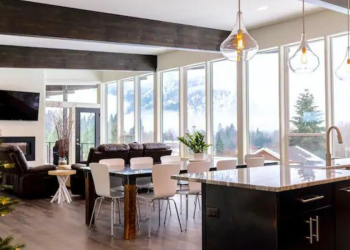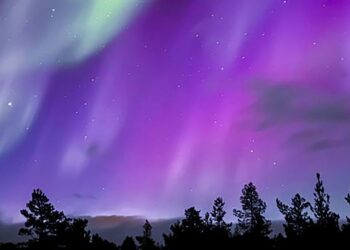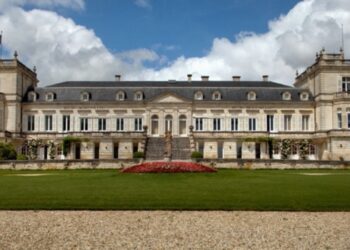Even the biggest Scrooge would feel his heart warming the second he stepped into one of the historic and dazzling Christmas markets in Europe. Often located in beautiful, bustling city squares or against wow-worthy backdrops, these Christmas markets brim with festive artisanal gifts to buy for loved ones — and of course for yourself.
Meandering through the vendor stalls, you’ll also catch whiffs of fragrant mulled wine and delicious things to eat from around the world, all of it glowing under soft Christmas lights and hearty holiday cheer. In other words: European Christmas markets are a magical way to spend some of your festive season and will transport you to a winter wonderland.
To help you narrow down where to go, we’ve rounded up the best Christmas markets in Europe. (And if you can’t make it to Europe, consider one of these Christmas markets in the U.S.)
WHEN DO CHRISTMAS MARKETS IN EUROPE BEGIN?

Every European Christmas market runs on its own schedule. But in general, many of the larger markets open in early to mid-November. Some wait to open until a little later — late November or early December — and the bulk stay open through Christmas Day. Some operate past Christmas, but rarely will they stay open into the New Year.
DRESDEN, GERMANY: STRIEZELMARKT CHRISTMAS MARKET
Said to be the oldest in Europe, the Striezelmarkt Christmas market dates back to 1434. Traces of history point to a market that offered striezel (typical sweets) and stollen, the distinctive Christmas bread from Dresden that’s studded with candied and dried fruits and covered with icing sugar. The market comes at the holiday from many angles, with brightly lit Christmas trees and nativity scenes, and elf cottages and Santa’s house. If you still want more Dresden Christmas markets, the city has nearly a dozen others.
- What to Eat: Christstollen (fruit and nut loaf), pflaumentoffel (a historic edible figurine made from dried plums), pfefferkuchen (ginger bread)
- What to Buy: Traditional wooden crafts, Christmas tree decorations, candles, sweets
- Where to Stay: The Bülow Palais is a historic hotel with its own sort of magic, and its location in the Baroque Quarter puts it near the much newer Augustus Market.
VIENNA, AUSTRIA: SCHÖNBRUNN PALACE CHRISTMAS MARKET
Everything the Austrian capital does is classy, and the Vienna Christmas markets are no exception. The Schönbrunn Palace Market is the city’s most famous, with a stunning location in front of the Habsburg Palace and a strong focus on arts and crafts. If you’re looking for more Christmas markets in the area, there’s also the Viennese Dream Christmas Market with its own striking setting in front of the city hall and caroling by international choirs on weekends, as well as a good number of smaller markets around the city.
- What to Eat: Waffles, crepes, and soups like alt ungarischen kesselgulasch (a traditional fish soup)
- What to Buy: Glass objects, wood figurines, pottery, needlework, and art
- Where to stay: The boutique Hotel Motto strikes the perfect balance between homage to a period in history (particularly the golden age in Paris) and the urban vibrancy of Vienna today.
MUNICH, GERMANY: MARIENPLATZ CHRISTMAS MARKET

Advent is the high season in Munich, a city that claims to have held traditional Christmas markets as far back as the 14th century. The best Munich Christmas market is arguably the Marienplatz Christkindlmarkt, held in front of the neo-Gothic town hall, an epicenter of Bavarian coziness. The 80-foot-high Christmas tree shines with the light of 3,000 candles, and at the nearly adjacent Kripplmarkt, there’s a particular focus on the goods that are needed to construct nativity scenes, such as stable lanterns and gifts from the Magi like frankincense and myrrh..
- What to Eat: Visit nearby Viktualienmarkt, the city’s year-round open market, which gets into the holiday spirit with Bavarian potato soup, sausages, mulled wine, Christmas carols, and a nativity scene in the beer garden.
- What to Buy: Nativity scenes (Germany’s largest market), lanterns, tree decorations, and toys
- Where to stay: Right outside the Viktualienmarkt, the stylish Louis Hotel has 72 well-designed rooms with handcrafted furniture.
LJUBLJANA, SLOVENIA: LJUBLJANA CHRISTMAS MARKETS
Slovenia has a well-deserved reputation for nature and sustainable tourism, but it also knows how to celebrate winter holidays in the capital. Ljubljana is known for its many Christmas markets (more than 50 stalls around town), with a hub of activity around Prešeren Square and along the Ljubljanica River. The artisan gifts — particularly the consumable ones, like schnapps and honey — on display at the vendor stalls are top quality and often sustainably produced, and the food, drink, and social scene are even better.
- What to Eat: Harvested honey, schnapps, pljeskavice (spiced minced meat), kranjska klobasa (Carniolan sausage), and jabolčni štrudelj (apple strudel)
- What to Buy: Handwoven goods like gloves and mittens, jewelry, ceramics, soaps, and wood carvings
- Where to stay: One of the most stylish boutique properties in town is Hotel Cubo, less than five minutes from the main Ljubljana Christmas market. Hedonists will appreciate the excellent breakfast, while conservationists can respect the sustainability initiatives.
BUDAPEST, HUNGARY: CHRISTMAS MARKET AT VOROSMARTY SQUARE

The Budapest Christmas markets stand out for their dedication to preserving local culture and traditions. They’re about small handmade gifts based on glass blowing, knitting, wood carving, candle making, pottery, embroidery, lace work. and leather crafting. The main markets are the Christmas market at Vorosmarty Square, which is beautifully presented, and the Budapest Basilica Christmas Fair, with its focus on Hungarian delicacies, such as chimney cake.
- What to Eat: Chimney cake, mulled wine, pálinka (fruit brandy), bratwurst, and goulash
- What to Buy: Leather goods, soaps, flowers, candy, and traditional Hungarian handicrafts
- Where to stay: The historic Matild Palace is a 15-minute stroll to either of the most famous markets, and it has special Christmas menus for the month of December at the Spago restaurant by Wolfgang Puck.
NUREMBERG, GERMANY: CHRISTKINDLESMARKT
The Nuremberg Christmas market differentiates itself with its strict regulations about what can and cannot be sold. Although it’s one of Europe’s biggest, oldest, and most popular, its organizers are still committed to limiting the sellers to locals and banning the sale of plastic toys and gewgaws, giving it the nickname “the little city o
- What to Eat: Bratwurst, dampfnudel (steamed sugary bread), schaumkuss (marshmallows and chocolate), and lebkuchen (traditional German cookie)
- What to Buy: Christmas tree decorations, clothing, jewelry, traditional figurines, and wooden toys (look for items with the original Christkindlesmarkt logo)
- Where to stay: The family-run Hotel Elch is a standout for its urban style within a timbered building that dates from the 14th century but now has a very contemporary soul.
PRAGUE, CZECH REPUBLIC: PRAGUE CHRISTMAS MARKETS
One of the sexiest cities in Europe, Prague hosts a terrific mix of traditional and contemporary Christmas markets. The two most important markets are a five-minute walk from one another, one in Old Town Square and the other in the iconic Wenceslas Square. With their brightly colored wooden stalls and holiday light displays, they illuminate the city and conjure a good dose of holiday magic.
- What to Eat: Pražská šunka (roasted boneless ham), klobása (grilled sausage), langoš (savory flatbread), and palačinky (fruit-filled crepes)
- What to Buy: Wool knit items like gloves and hats, traditional Christmas decor, candles, and toys
- Where to stay: The Emblem Hotel is a lifestyle property with 59 gorgeous rooms, a chill-out lounge, and an unbeatable rooftop terrace.
STRASBOURG, FRANCE: STRASBOURG CHRISTMAS MARKET

Billing itself the French Capital of Christmas, romantic Strasbourg is located on the border and is heavily influenced by Germany. It lights up with miles and miles of fairy lights. The main Strasbourg Christmas market, located adjacent to the massive cathedral, has more than 300 stalls selling gifts and snacks. A separate Advent Village has workshops, performances, and a fir tree forest, and the OFF Market emphasizes the social and solidarity economy with upcycled and ethically produced products.
- What to Eat: Flammkuchen (flambe tart), fresh pretzels, bredele (tiny sweet treats), and chocolate
- What to Buy: Glass objects and jewelry, candles, herbs, handmade toys, pottery, and jewelry
- Where to stay: The five-star Maison Rouge is just a five-minute walk from the cathedral and the market activities.
BRUSSELS, BELGIUM: WINTER WONDERS EVENT
The best Brussels Christmas market is the Winter Wonders event. It’s unique because it stays open through the first Sunday in January when most Western European markets close just before Christmas. This vibrant Christmas market fills Grand-Place, the city’s central historic square, and many of the streets around it, with more than 200 stalls, a ferris wheel, and an ice rink. A highlight is the Sound & Light Show, which fills the UNESCO-designated square with colors and music.
- What to Eat: Waffles, chocolate, glühwein (mulled wine), and tartiflette (cheesy potatoes)
- What to Buy: Christmas village houses, woven goods like scarves and slippers, traditional holiday decor, and toys
- Where to stay: With its location just one block from Grand-Place, Hotel Amigo has a winning design that marries the historic and the contemporary, with an impressive art collection.
KRAKOW, POLAND: KRAKOW CHRISTMAS MARKET
Krakow’s Christmas market takes place on the city’s main square, Rynek Glowy, which has for centuries been a center of trade in Poland. In November, wooden stalls appear, selling Christmas decorations, gifts, cards, and sweets and other foods like pierogies and smoked cheese, many of which are made by local artisans. Children’s ensembles and other artists perform carols.
- What to Eat: Oscypek (smoked cheese), chocolate-covered fruit, roasted nuts, grilled sausage, and mulled wine
- What to Buy: Paper goods, woodcrafts, and traditional Christmas ornaments, decorations, and toys
- Where to stay: The design-forward Balthazar Hotel (note the Christmas-related name) is just off Rynek Glowy and has sumptuous Art Deco interiors.
Featured image by Liam McKay via Unsplash; Travel Curator may earn a commission from product or booking links on this page







